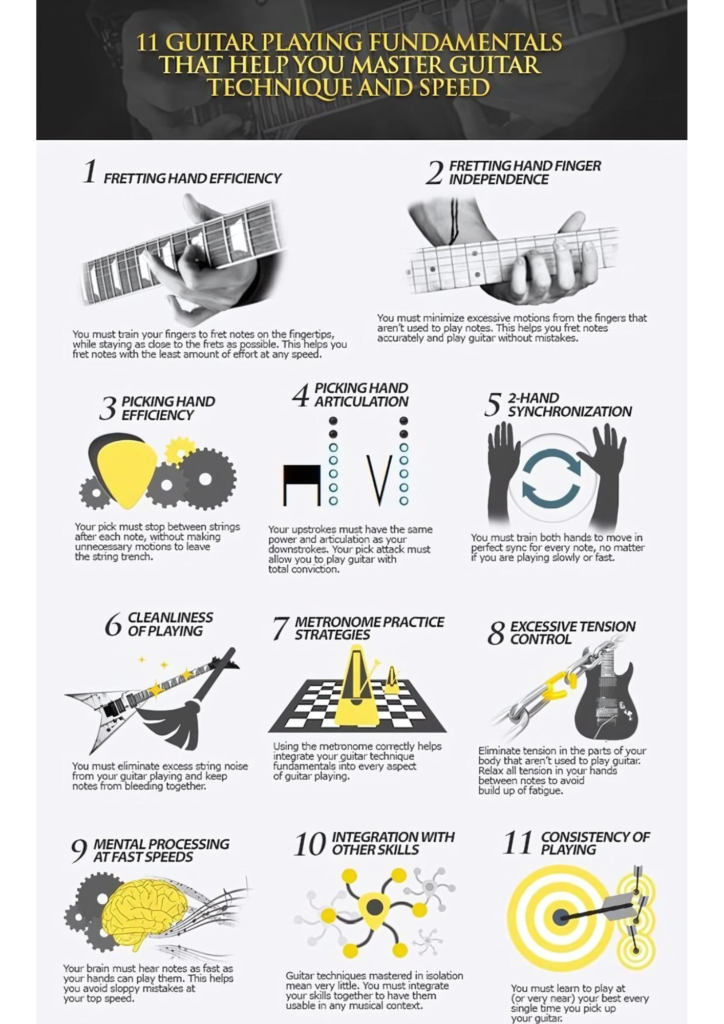Strumming is a fundamental guitar technique that forms the rhythmic backbone of many songs. While basic strumming is essential, advancing your skills with techniques like palm muting and percussive strumming can add depth and complexity to your playing. This guide delves into these advanced strumming techniques, providing insights and tips to enhance your guitar rhythms.

1. Palm Muting
Overview:
Palm muting involves lightly resting the edge of your palm on the strings near the bridge while strumming or picking. This technique creates a muted, percussive sound, commonly used in rock, punk, metal, and even acoustic styles for dynamic contrast.
Technique:
- Hand Position: Place the fleshy part of your palm (near the pinky) gently on the strings, close to the bridge. The exact position can vary depending on the desired muting effect.
- Pressure Control: Apply just enough pressure to dampen the strings, reducing their sustain while allowing them to produce a clear, muted sound.
- Strumming or Picking: Strum or pick the strings while maintaining the palm position. Adjust the pressure and position to achieve the desired muting effect.
Practice Tips:
- Start Slow: Begin with downstrokes only, focusing on maintaining consistent muting.
- Vary Pressure: Experiment with different pressure levels to control the degree of muting.
- Combine with Open Chords: Practice switching between open strumming and palm-muted strumming within the same progression.
Application Example:
- Palm Muted Power Chords:
e|--------------------------------|
B|--------------------------------|
G|--------------------------------|
D|--2-2-2-2---4-4-4-4-------------|
A|--2-2-2-2---4-4-4-4-------------|
E|--0-0-0-0---2-2-2-2-------------|2. Percussive Strumming

Overview:
Percussive strumming adds rhythmic interest by incorporating percussive sounds created by hitting or muting the strings with your strumming hand. This technique is often used in genres like flamenco, funk, and acoustic singer-songwriter styles.
Techniques:
- Muted Strumming: Use your fretting hand to lightly touch the strings, muting them while strumming to produce a percussive “chuck” sound.
- Strum Slap: After a downstroke, quickly bring your strumming hand down onto the strings to create a slap sound, adding a snare-like effect.
- Thumb Slap: Use the side of your thumb to hit the strings or the body of the guitar for a deeper percussive sound.
Practice Tips:
- Isolate Movements: Practice each percussive element separately before combining them with chords and regular strumming.
- Consistency: Focus on consistent timing and dynamics to integrate percussive elements smoothly into your playing.
- Combine Techniques: Experiment with mixing percussive strumming with regular strumming patterns.
Application Example:
- Muted Strumming and Slap:
e|-----------------|
B|-----------------|
G|--X--X--X--X--X--|
D|--X--X--X--X--X--|
A|--X--X--X--X--X--|
E|--X--X--X--X--X--|3. Hybrid Strumming


Overview:
Hybrid strumming combines strumming with fingerpicking, allowing for greater versatility and dynamics. This technique is used in various styles, from folk to contemporary acoustic music.
Technique:
- Pick and Fingers: Hold a pick between your thumb and index finger while using your middle, ring, and pinky fingers to pluck individual strings.
- Strum and Pluck: Strum with the pick for fuller chords and use your fingers to pluck specific strings for melodic lines or bass notes.
Practice Tips:
- Coordination: Develop coordination between the pick and your fingers by practicing simple patterns slowly.
- Balance: Focus on balancing the volume between strummed and plucked notes to create a cohesive sound.
- Patterns: Start with basic patterns and gradually incorporate more complex rhythms and melodies.
Application Example:
- Hybrid Picking Pattern:
e|-------0--------|
B|-----1----------|
G|---0-----0------|
D|------------2---|
A|----------------|
E|--3-------------|4. Syncopated Strumming
Overview:
Syncopation involves placing emphasis on off-beats or unexpected beats within a measure, creating a more dynamic and rhythmically interesting strumming pattern. This technique is widely used in funk, reggae, and pop music.
Technique:
- Understand the Beat: Familiarize yourself with the basic beat of the song (e.g., 1-2-3-4) and identify the off-beats (e.g., the “ands” between the beats: 1-and-2-and-3-and-4-and).
- Emphasize Off-Beats: Strum more forcefully on the off-beats or use upstrokes to create the syncopated effect.
- Vary Dynamics: Combine stronger and softer strums to accentuate the syncopation.
Practice Tips:
- Clap and Count: Clap along with a metronome while counting the beats and off-beats to internalize the rhythm.
- Start Simple: Begin with basic syncopated patterns and gradually increase complexity.
- Listen and Imitate: Listen to songs with syncopated rhythms and try to replicate the strumming patterns.
Application Example:
- Syncopated Strumming Pattern:
e|---x---x---x---x-|
B|---x---x---x---x-|
G|---2---x---2---x-|
D|---2---x---2---x-|
A|---0---x---0---x-|
E|---x---x---x---x-|5. Dynamic Strumming
Overview:
Dynamic strumming involves varying the intensity, speed, and rhythm of your strumming to add expression and emotion to your playing. This technique is crucial for creating musical interest and contrast within a song.
Techniques:
- Volume Control: Vary the volume of your strumming by adjusting the force with which you strike the strings.
- Tempo Changes: Introduce slight tempo changes or pauses to create tension and release.
- Rhythmic Variation: Mix different strumming patterns and rhythms within a song to keep it engaging.
Practice Tips:
- Dynamic Exercises: Practice playing the same chord progression at different volumes and speeds.
- Emotion and Feel: Focus on conveying the emotion of the song through your strumming dynamics.
- Record and Review: Record your playing to evaluate and refine your dynamic strumming.
Application Example:
- Dynamic Strumming Pattern:
e|----0----0---0----0-|
B|----1----1---1----1-|
G|----0----0---0----0-|
D|----2----2---2----2-|
A|----3----3---3----3-|
E|----x----x---x----x-|Conclusion
Advanced strumming techniques like palm muting, percussive strumming, hybrid strumming, syncopation, and dynamic strumming can significantly elevate your guitar playing. These techniques add variety, depth, and expression to your music, making your performances more engaging and dynamic. By practicing these techniques and incorporating them into your playing, you’ll develop a more versatile and expressive strumming style. Happy strumming!


- 🎶 Flute Lesson for Beginners: Learn Your First Notes Easily
- Homesteading Knowledge: Back-to-Basics Skills for Self-Reliant Living
- 🎸 Dmaj7 Guitar Chord: A Smooth and Dreamy Sound for Your Songs
- July 5th in America: The Quiet Day After the Boom
- Who Is Vanessa Trump? Inside the Life of Donald Trump Jr.’s Former Wife

